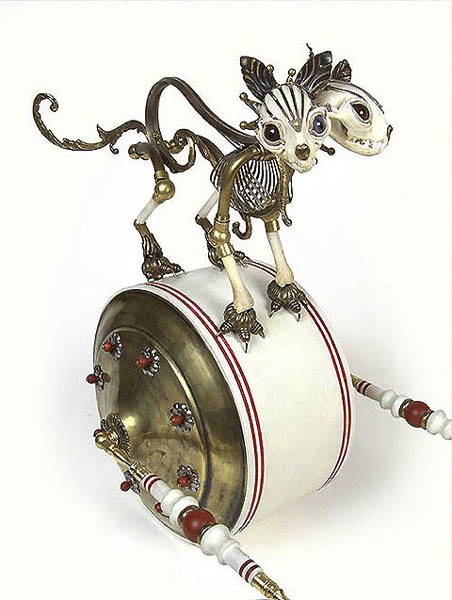This morning I’m reading the gorgeous review copy of The Art of Steampunk (the revised second edition). Its full title is The Art of Steampunk: Extraordinary Devices and Ingenious Contraptions from the Leading Artists of the Steampunk Movement. It’s a coffee table paperback, with beautiful photos of steampunk art and short articles, focused on the 2009-2010 Steampunk exhibit at the Oxford Museum of the History of Science.
The photos are awesome, glossy and often full-page, and I liked having a collection of them. The art is admirable! I especially enjoyed Mikhail Smolyanov’s motorcycles and Jessica Joslin’s mechanical animals.

My favorite art piece by far is Joey Marsocci’s Amelia Earhart Navigational System which has a brain in a bubbling, steaming jar on top of what looks like a wooden radio cabinet and which you can type on to get audio clips of Amelia Earhart’s voice (as a paranormal connection). It looks completely amazing, and I’m a sucker for anything that’s a complex framing of history. Here’s a short video about the piece:
Richard Nagy’s steampunk laptop designs are also just great!
As I read The Art of Steampunk this morning I spent some very enjoyable time looking up the artists and their work. I think this book could be a fun starting point for anyone interested in adding some biographies to Wikipedia, and their notability is easily sourced.
I am very fond of analyzing anthologies, who is in them and why, how genres or cultures are defined, looking at who’s in the index or table of contents, and so on, all in a political context. It is a lifetime habit! As maybe is obvious from my enormous anthology project on Spanish-American women poets I particularly like to look at the inclusion and non-inclusion of women.
Of the 17 artists featured in the museum exhibition, or at least in the book’s description of the exhibition, only 2 are women. The book’s introduction says,
Although it’s technocentric in styling, Steampunk design is definitely not just a “boy’s club” of enthusiasts. Its fans and creators are equally divided among women and men, young and old alike, from around the world.
Claims to diversity stand out to me in anthologies when they are not actually reflected in the work represented. It would be better, I think, to acknowledge the diversity represented — in this case artists from several different countries — and also acknowledge where it is lacking or flawed.
A section at the front shows work and biographical profiles for eight more artists whose work was perhaps not known to the book’s editor until after the exhibition, and the work featured dates from after 2009. 6 of these 8 artists are women. I note it as an improvement in apparent diversity in the book, even if it was not reflected in the museum exhibition.
I was somewhat annoyed, in this context, that the book’s editor referred to Mary Shelley in another attempt to be “diverse”, but spelled her name wrong.
While reading this book I thought of postcolonialist steampunk and Jaymee Goh’s blog Silver Goggles, always worth reading. I like her critiques of racism and colonialism in steampunk communities and the framing of “what steampunk is”. Beyond Victoriana: A Multicultural Perspective on Steampunk by Ay-leen also explores, well, actual diversity in the culture and its representation.
Beyond Victoriana is the oldest-running blog about multicultural steampunk and retro-futurism–that is, steampunk outside of a Western-dominant, Eurocentric framework. Founded in 2009, Beyond Victoriana focuses on non-Western cultures, underrepresented minorities in Western histories (Asian / Pacific Islander, Middle Eastern, First Nation, Hispanic, black / African & other marginalized identities), and the cultural intersection between the West and the non-West.
The Art of Steampunk didn’t overtly focus on pith helmets and celebrations of colonialism but it does not go deep into the possibilities despite its sweeping claims of diversity. So while I love the book, I wish that there were more of it!
Wow!
Thank you for this article. I falled in love in these photos!